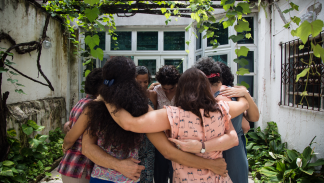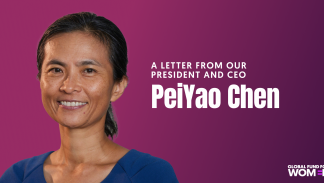Advancing Positive Sexuality and Abortion Rights by Tackling Stigma
By Leila Hessini, Vice President of Programs, Global Fund for Women and Rufaro Kangai, Program Director, Sexual Health and Reproductive Rights, Global Fund for Women
Research and practice show that challenging stigma is necessary in order for all people to access comprehensive sexual and reproductive health and rights, including access to safe, non-judgmental, quality abortion care. While abortions are one of the most common medical procedures and can be managed safely by women and a range of health care providers, abortion stigma contributes to its social, medical, and legal marginalization.
It is important to understand that abortion stigma is never just about abortion, but plays out and attaches to different social issues and political debates in our respective societies. In countries that are strongly influenced by Catholic institutions and in the U.S., abortion has become a lynch-pin in political debates and culture wars, while in countries where contraception is readily available, abortion stigma may be a form of punishment for women who choose not to or are unable to access contraceptives. In pro-natalist countries, abortions might be stigmatized due to the desire by state powers for women to have large family sizes. Ultimately, abortion stigma is directly related to social and cultural norms related to women’s authority, place, and status in society and is a direct way of controlling and subjugating women and limiting their life opportunities.
The consequences of abortion stigma are wide and deep. In countries such as Nigeria, where maternal death from unsafe abortion is exorbitantly high, the public health consequences of women not having access to safe abortions truly is a matter of life or death. Latin America has some of the world’s most restrictive abortion laws—and high rates of maternal death and injury as a result.
Even in countries where abortion is legally available, stigma related to abortion means that most women still have abortions outside the formal health care system. For example, while abortion is legal in Nepal, stigma remains a powerful barrier. Women who seek out abortions are often ostracised “at the family level, the community level, and at any religious functions,” says Shanta Laxmi Shrestha, Chairperson of Beyond Beijing Committee, a Global Fund for Women grantee partner. “Unless we address abortion stigma, even though the services are very much available, women who need them will not get them because of the stigma.”
In response to the ongoing assault on abortion access, women’s rights organisations are using multiple strategies to address stigma. For example, discriminatory and punitive abortion laws are major causes of abortion stigma. Laws perpetuate stigma in numerous ways—they create categories of “good abortions” versus “bad abortions” and who can and cannot obtain an abortion. This is non-existent for any other medical procedure. Women’s movements have worked to liberalise abortion laws across the globe; Ireland recently liberalized its abortion laws and Chile expanded the legal indicators for abortion.
Working to ensure that abortion care is offered in women-centered ways is also critical to reducing stigma. Semillas, a women’s fund in Mexico, works to address aspects of healthcare service delivery that stigmatize certain groups of women, especially those who are young and from disadvantaged social groups. Mexico’s Fondo de Aborto para la Justicia Social MARIA seeks to destigmatize abortion by normalizing its existence and providing women with easy to access information and care through hotline and in-person consultations. They also provide support for women from states where abortion is legally restricted to travel to Mexico City where abortion is legal.
Decentralizing care through informal networks of activists is a strategy used by groups such as Centro Las Libres de Información en Salud Sexual Región Centro AC (Las Libres) in Mexico. Las Libres supplies women with abortion kits to conduct safe, self-induced medical abortions. Self–managed abortions are an innovative strategy led by women-led organisations that allow women to access abortions safely in their homes, reducing stigma, as well as reducing the risk of being criminalized by a medical practitioner who may hand them over to the authorities. The Line Aborto Libre, a collective of feminists in Chile, operates a 24-hour hotline to ensure that women have access to safe abortion information, care, medicine, and counselling. These interventions are centered on the needs of the women and are made to ensure women can safely access abortion services when and where they need them. The Indonesia-based feminist and rights-based organization, Samsara promotes the access to education and information on sexual health and reproductive rights and safe abortion in multiple languages through apps accessible via mobile phones and tablets.
Ultimately, we know that because stigma is produced for many reasons, in many ways, and against many women, only a comprehensive approach—reframing harmful language, changing discriminatory policies and practices, and ensuring implementation of quality services—will create a future where abortion stigma is part of our past.
This article is an edited excerpt from a longer article included in the publication ARROW for Change: The Right to Choose, Vol. 24 No. 1, edited and produced by the Asian-Pacific Resource and Research Centre for Women (ARROW). To read the full article, as well as contributions to the publication from other women’s human rights organizations, click here.
Abortion stigma is directly related to women’s authority, place, and status in society and is a direct way of controlling and subjugating women and limiting their life opportunities.


